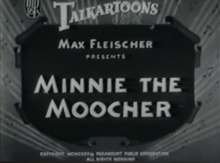| Minnie the Moocher | |
|---|---|
 Original opening card Original opening card | |
| Directed by | Dave Fleischer |
| Produced by | Max Fleischer |
| Starring | Cab Calloway and His Orchestra Mae Questel Margie Hines |
| Animation by | Willard Bowsky Ralph Somerville Bernard Wolf |
| Color process | Black-and-white |
| Production company | Fleischer Studios |
| Distributed by | Paramount Pictures |
| Release date |
|
| Running time | 8 minutes |
| Country | United States |
| Language | English |
Minnie the Moocher is a 1932 Betty Boop cartoon produced by Fleischer Studios and released by Paramount Pictures.
In 1994, Minnie the Moocher was voted #20 of the 50 Greatest Cartoons of all time by members of the animation field.
Plot
The cartoon opens with a live action sequence of the famous black musician Cab Calloway and his orchestra performing an instrumental rendition of "St. James Infirmary". Betty Boop gets into an argument with her strict immigrant parents when she will not eat the traditional Hasenpfeffer. She runs away with her puppy boyfriend Bimbo, and sings excerpts of the Harry Von Tilzer song "They Always Pick on Me" and the song "Mean to Me". Koko the Clown from the earlier short Out of the Inkwell makes a cameo appearance as Betty writes her note.
Betty and Bimbo end up in a cave where a walrus-like apparition appears (voiced by Calloway), who sings "Minnie the Moocher" and dances to the melancholy song. Calloway is joined in the performance by other ghosts, goblins, skeletons, and other creatures. Betty and Bimbo are subjected to skeletons drinking at a bar; ghost prisoners sitting in electric chairs; a cat with empty eye-sockets feeding her equally empty-eyed kittens; and so on. Betty and Bimbo both change their minds about running away and rush back home with the ghouls in hot pursuit. Betty makes it safely back to her home and hides under the blankets of her bed. As she shakes in terror, the note she earlier wrote to her parents tears, leaving "Home Sweet Home" on it. The film ends with Calloway performing the instrumental "Vine Street Blues".
Cast
- Mae Questel/Margie Hines as Betty Boop
- Margie Hines as Betty's mother
- Claude Reese as Bimbo
- William Pennell as Betty's father
- Cab Calloway and His Cotton Club Orchestra as Cavern Monsters
Reception
The Film Daily, on January 10, 1932, wrote: "This Max Fleischer musical cartoon is one of the best turned out so far with the cute pen-and-ink star, Betty Boop, who seems to be getting more sexy and alluring each time, and her boyfriend, Bimbo. The musical portion is supplied by Cab Calloway and his orchestra, and what these boys can't do to the 'Minnie the Moocher' number isn't worth mentioning. Cab and his boys are shown only for a brief moment at the opening. Then a cartoon character, a big walrus with serpentine hips, performs the gyrations to the tune of the 'Minnie' song. The effect is short of a knockout, especially to those who are familiar with Cab's stuff on the radio or stage or night club. Betty Boop's part in the action concerns her running away from home because of her bad parents. With Bimbo she goes into a cave, where spooky figures and eerie noise give them such a scare that they beat it back home".
Notes
- Clips of the redrawn colorized version were used in the compilation film Betty Boop for President: The Movie (1980).
- In a scene from the film Look Who's Talking Too (1990) there is a little Mickey watching this cartoon on TV.
References
- Scott, Keith (2022). Cartoon Voices from the Golden Age, 1930-70. BearManor Media. p. 332. ISBN 979-8-88771-010-5.
- Lenburg, Jeff (1999). The Encyclopedia of Animated Cartoons. Checkmark Books. p. 142. ISBN 0-8160-3831-7.
- Beck, Jerry (1994). The 50 Greatest Cartoons: As Selected by 1,000 Animation Professionals. Turner Publishing. ISBN 978-1878685490.
- Vilas-Boas, Eric; Maher, John, eds. (October 5, 2020). "The 100 Sequences That Shaped Animation". Vulture.
The film was a follow-up to Calloway's popular Minnie the Moocher Fleischer short from the year prior, which opened with live footage of Calloway dancing before rendering him into a walrus.
- Hunt, Kristin (August 29, 2019). "Remaking Betty Boop in the Image of a Housewife". JSTOR Daily. Retrieved April 3, 2022.
- Pointer, Ray (June 9, 2017). The Art and Inventions of Max Fleischer: American Animation Pioneer. McFarland. p. 136. ISBN 978-1-4766-2741-0. Retrieved August 12, 2022.
- Sampson, Henry T. (1998). That's Enough, Folks: Black Images in Animated Cartoons, 1900-1960. Scarecrow Press. pp. 188–189. ISBN 978-0810832503.
External links
- Minnie the Moocher at IMDb
- Watch Minnie the Moocher (uncensored) in fully restored HD at Laugh Bureau Vintage
- Minnie the Moocher at Big Cartoon Database
- Minnie the Moocher at Internet Archive
- Minnie the Moocher at YouTube in highest-quality pristine restoration with correct aspect ratio.
- 1932 films
- 1930s American animated films
- Films originally rejected by the British Board of Film Classification
- Betty Boop cartoons
- Short films directed by Dave Fleischer
- Paramount Pictures short films
- Fleischer Studios short films
- 1930s English-language films
- English-language short films
- American animated black-and-white films
- 1932 animated short films